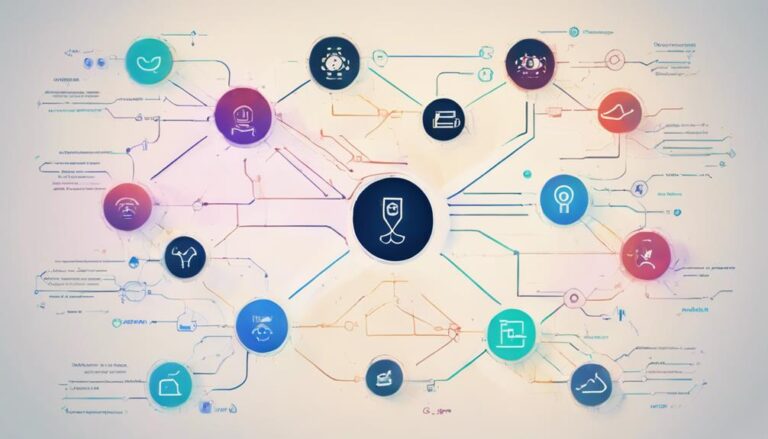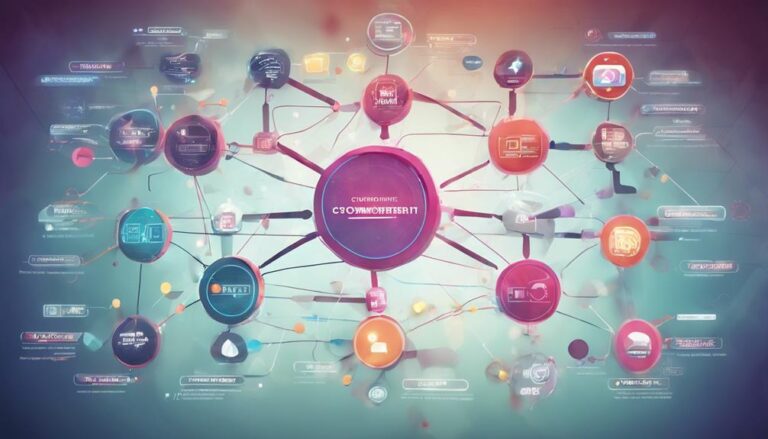When I look for the best tools for customer journey mapping, I find that Lucidchart and Microsoft Visio shine with their easy diagramming features. Adobe Experience Cloud stands out for analytics, while Figma excels in transforming design into code. Smaply is fantastic for visualizing experiences. For AI-powered insights, IBM Journey Designer is excellent. For collaboration, Miro, Trello, and Asana offer robust solutions. These tools help unify touchpoints, identify pain points, and facilitate team collaboration effectively. If you're keen to explore these tools' unique capabilities further and see how they can transform your business strategies, you'll definitely find this interesting.
Key Takeaways
- Lucidchart: Excellent for creating detailed customer experience diagrams with intelligent diagramming and customizable templates.
- Adobe Experience Cloud: Automates processes and provides comprehensive analytics for in-depth customer journey insights.
- Miro: Ideal for real-time collaboration, user story mapping, and sprint planning.
- IBM Journey Designer: Utilizes AI for predictive analytics and automated data analysis to enhance customer interactions.
- Figma: Transforms design into code, optimizing user experience and collaboration for design teams.
Why Use Customer Journey Mapping Tools
Understanding why we should use customer journey mapping tools starts with recognizing their ability to provide a unified view of touchpoints, pain points, and opportunities along the customer's path. These tools streamline the process of identifying and analyzing customer touchpoints, allowing us to gather invaluable customer insights.
By incorporating both quantitative and qualitative data, we can visualize the customer journey more effectively. Collaboration features enable cross-functional teams to work seamlessly, integrating customer feedback to identify pain points and opportunities for improvement.
With a robust customer experience management platform, we can continuously iterate and enhance the customer journey. This holistic approach not only sharpens our strategy but also fosters innovation and growth, ensuring we're always one step ahead in customer satisfaction.
Key Features of Top Tools
As we explore the key features of top customer journey mapping tools, it's clear that these platforms are designed to enhance every aspect of understanding and optimizing the customer experience.
Tools like Lucidchart and Microsoft Visio offer intelligent diagramming and extensive templates, simplifying the creation of insightful customer journey maps.
Adobe Experience Cloud automates processes across online, mobile, and physical channels, providing detailed analytics and data for deeper insights.
Figma stands out by transforming design into code, optimizing the user experience.
Smaply focuses on visualizing customer experiences and understanding segments, fostering better collaboration.
These customer journey mapping tools, with their robust features and capabilities, empower businesses to innovate and refine their strategies effectively.
AI-Powered Tools for Journey Mapping

Leveraging AI-powered tools for journey mapping, such as IBM Journey Designer, allows businesses to gain deeper insights through predictive analytics and automated data analysis, ultimately enhancing the customer experience.
These AI-powered tools streamline the mapping process, greatly saving time and boosting accuracy. With sophisticated AI capabilities, IBM Journey Designer identifies patterns and trends in customer journeys, revealing opportunities that might otherwise be overlooked.
This advanced level of analysis enhances customer journey insights, enabling businesses to make data-driven decisions that drive growth. By harnessing artificial intelligence, companies can optimize their customer interactions, ensuring a seamless and personalized experience.
The result isn't just an improved mapping process but a more profound understanding of customer behavior and needs.
Best Visualization Tools
When it comes to mapping out the customer journey, the best visualization tools like Miro, Custellence, Gliffy, UXPressia, and Lucidchart offer unparalleled features that guarantee clarity and collaboration.
Miro excels with user story mapping and sprint planning, making it an invaluable customer journey mapping software.
Custellence's intuitive interface and flexible structures simplify online Customer Journey Mapping.
Gliffy supports creating technical diagrams, beneficial for detailed customer experience diagrams.
UXPressia stands out with its cloud platform, offering pre-built templates for real-time collaboration.
Lucidchart enables the creation of detailed customer experience diagrams, boosting customer engagement.
Each tool ensures that the mapping process is insightful, data-driven, and innovative, tailored to meet the evolving needs of today's businesses.
Collaboration Tools for Teams

In today's fast-paced business environment, collaboration tools like Miro, Trello, and Asana are indispensable for teams aiming to create effective customer journey maps. These tools enhance team communication and efficiency, vital for real-time collaboration and agile project management. Platforms like UpWave and Mural provide robust task management, enabling seamless information acquisition and optimizing journey maps.
| Tool | Key Feature |
|---|---|
| Miro | Real-time collaboration |
| Trello | Task management |
| Asana | Agile project management |
| Workzone | Cloud-based solutions |
Customer Experience Software
While collaboration tools streamline team efforts in crafting customer journey maps, customer experience software takes it a step further by enabling businesses to analyze and enhance every interaction with their customers. Tools like Smaply, IBM Journey Designer, and Visual Paradigm excel in visualizing and managing customer touchpoints.
These platforms offer real-time analytics, empowering businesses to understand and act on customer feedback immediately. Collaborative tools such as InMoment and SuiteCX facilitate seamless internal communication, guaranteeing that insights lead to actionable improvements.
Integration With Data Sources

Integrating data sources into customer journey mapping tools like UXPressia, Lucidchart, and Custellence allows us to create a more thorough and insightful view of our customers' experiences. By leveraging integrations with data sources, we enhance customer journey analysis and develop detailed customer journey maps.
Lucidchart, for instance, provides multiple solutions for integrating data sources, offering a more nuanced perspective. Custellence excels at integrating data sources to link insights effectively. Smaply supports linking insights from various data sources, improving our customer experience mapping.
SuiteCX by QuestionPro facilitates integrated survey data, offering a holistic view of customer journeys. These integrations enable us to compile and analyze diverse data streams, ultimately refining our approach and elevating the customer experience.
Customizable Templates
When I use customizable templates in tools like UXPressia or Lucidchart, I appreciate the pre-designed layout options that save me time and effort.
The drag-and-drop interface makes it simple to tailor the map to specific customer needs, while real-time collaboration features guarantee my team stays aligned.
Pre-designed Layout Options
Pre-designed layout options in customer journey mapping tools give users a structured yet flexible foundation to efficiently tailor maps to their unique customer interactions. These customizable templates are a game-changer, allowing me to address specific needs without starting from scratch.
By streamlining the mapping process, these pre-designed options help create thorough journey maps that capture every critical touchpoint. I can easily adapt the templates to fit my organization's requirements, ensuring that every interaction is represented accurately.
This approach not only saves time but also enhances the quality of insights derived from the maps. The ability to efficiently modify these templates makes them invaluable for anyone looking to innovate and optimize their customer journey mapping efforts.
Drag-and-Drop Interface
Building on the advantages of pre-designed layout options, the drag-and-drop interfaces in tools like UXPressia and Lucidchart take customization to the next level by allowing users to easily tailor every element of their customer journey maps.
These tools offer customizable templates that can be adjusted to meet specific business needs and customer journey stages. With a user-friendly interface and flexible map structure, they make it simple to visualize and analyze the entire journey.
Real-time Collaboration Features
Real-time collaboration features in tools like UXPressia and Lucidchart empower teams to simultaneously create and edit customer journey maps, ensuring that everyone's insights are captured and integrated seamlessly. These tools provide customizable templates, making it easy for teams to adapt the mapping process to their specific needs.
Microsoft Visio and Gliffy also offer customizable templates, streamlining the setup structure for various industries.
Enhanced teamwork:
Real-time collaboration guarantees that teams working together can instantly see and build upon each other's ideas.
Efficiency:
Predefined templates in tools like Custellence and Smaply save time, allowing teams to focus on deeper insights.
Flexibility:
Customizable templates allow for industry-specific adjustments, making the customer journey maps highly relevant and actionable.
This seamless integration fosters innovation and precision in mapping customer journeys.
Analytics and Reporting Tools

When we explore analytics and reporting tools like Google Analytics, we uncover invaluable quantitative data that reveals customer behavior across various touchpoints. These analytics tools help us understand user interactions, identify pain points, and optimize the customer journey.
For instance, Google Analytics 4 offers advanced features such as funnel analysis, heatmaps, and recordings to meticulously track user behavior. Complementing this, Heap provides qualitative insights that pinpoint user behavior on specific pages, allowing us to fine-tune our strategies.
Choosing the Right Tool
Selecting the right customer journey mapping tool hinges on understanding your specific needs and how each tool's features align with those requirements. To make an informed decision, I focus on several key aspects that drive innovation and efficiency:
- Collaboration features: These promote team communication and input, guaranteeing everyone's voice is heard.
- Real-time editing and dynamic mapping: These capabilities enable agile adjustments and keep the mapping process fluid.
- Customizable templates and data type supported: Adaptable options and compatibility with various data types guarantee the tool fits unique mapping needs.
Additionally, I scrutinize the pricing model for budget alignment and verify security certifications for data protection. By balancing these factors, I can choose a tool that enhances my customer journey mapping efforts effectively.
Frequently Asked Questions
What Is a Customer Journey Mapping Tool?
A customer journey mapping tool lets me visualize user personas, behavioral segmentation, and empathy maps. It helps analyze touchpoints and journey stages, incorporating customer feedback and pain points, to enhance experience design through journey analytics and service blueprints.
What Are the 5 a Used for Building a Customer Journey Map?
Imagine a tapestry of customer experiences. I use persona development, touchpoint analysis, feedback integration, empathy mapping, and user scenarios. These elements help me identify pain points, set goals, map interactions, design experiences, and visualize techniques innovatively.
What Are the 7 Steps to Map the Customer Journey?
To map the customer journey, I start with persona development and touchpoint analysis. Then, I use empathy mapping to identify pain points, user goals, experience stages, and journey milestones. Incorporating feedback loops and scenario planning guarantees continuous improvement.
What Are the 5 Key Components of Customer Journey Map?
Analyzing touchpoints, understanding customer personas, and mapping moments are essential. I examine interaction channels, user experiences, and journey stages to gain customer insights, chart their emotional journey, and identify pain points for a detailed service blueprint.
Conclusion
In my journey to discover the best customer journey mapping tools, I've found that the perfect pick profoundly depends on your specific needs.
From AI-driven insights to customizable templates, these tools transform tedious tasks into seamless solutions.
As you seek the right fit, let data drive decisions and empathy guide your goals.
Remember, the right tool can turn your customer experience from fragmented and frustrating to fluid and fulfilling.
Choose wisely, and your efforts will surely succeed.






